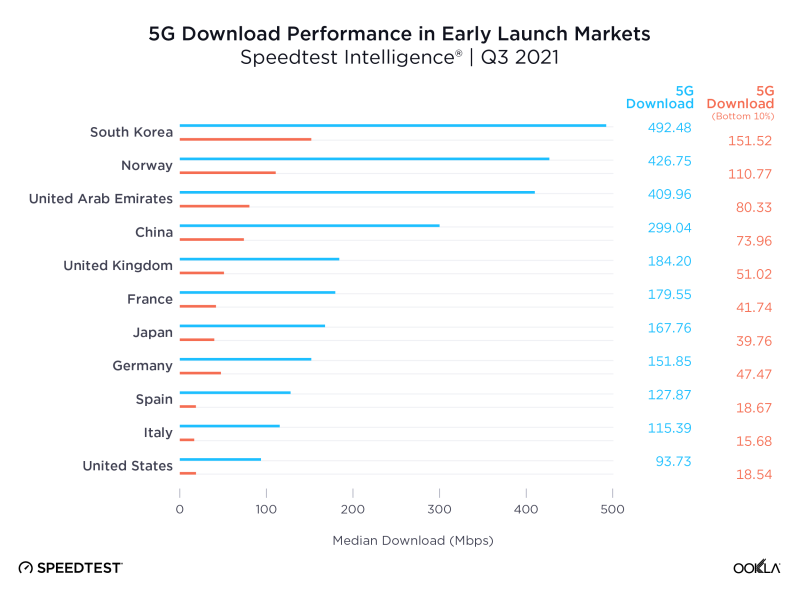A new 5G report from Ookla places the U.S. atop the global leader board for 5G availability. However, in a lineup of countries where 5G was early to launch, the U.S. falls comparatively short and ranked last when it comes to speed.
Major U.S. carriers AT&T, T-Mobile and Verizon have all launched versions of 5G broadly enough to tout the claim of nationwide service. T-Mobile also marked a recent milestone on its mid-band 2.5 GHz deployment of reaching 200 million people ahead of schedule and next has sights set on 300 million by end of 2023.
Using lower-band spectrum and technology like dynamic spectrum sharing (DSS) helped carriers roll out broader 5G coverage but with well documented limits in terms of speed improvements.
RELATED: Verizon relies on dynamic spectrum sharing more widely than AT&T – report
For Ookla’s “5G Availability” category, the network testing company analyzed to see what percent of users on 5G-capable devices spent the majority of their time on 5G. In the U.S. nearly half (49.2%) of users with 5G devices are connected to 5G most of the time. Netherlands was the next closest market at 45.1%, followed by South Korea at 43.8%. Only the top 8-ranked countries had more than 25.5% of users on 5G most of the time. Sixteen countries were below the 9% threshold for 5G availability, including Brazil at just 0.8%. See the full list and additional analysis from Ookla here.
In Q3 SpeedTest results Ookla also looked at performance in 11 countries that were early movers on 5G.
South Korea led the pack on 5G downloads with median speeds of 492 Mbps (the bottom 10% was still 151.52 Mbps). Also punching above 400 Mbps was second-place Norway and third-place United Arab Emirates with 5G download speeds of 427 Mbps and 410 Mbps, respectively. Next came China with median speeds of 299 Mbps.
The remaining seven countries were notably slower, though all except the U.S. reached 5G download speeds between 115 Mbps and 184 Mbps. At 93.73 Mbps, U.S. median 5G download speeds were the slowest and trailed behind the five European countries and Japan that also fell on the lower end of rankings. The bottom 10% for 5G download in the U.S. clocked a mere 18.54 Mbps, according to Ookla.

The type of spectrum used in the U.S. for early 5G rollouts often garners attention for performance that was more akin to 4G LTE. While T-Mobile has 2.5 GHz at its disposal carriers like AT&T and Verizon have yet to roll out mid-band 3.7 GHz frequencies that resemble the first spectrum option for 5G in several other parts of the world. After a one-month delay agreed to by the two carriers over FAA safety concerns, the first U.S. C-band activations are expected shortly after the New Year.
And as recent analysis by RootMetrics (which Ookla happens to be acquiring) showed, T-Mobile’s 5G network that already leverages mid-band 2.5 GHz has seen significant speed improvements since the first half of 2021. Several markets had median 5G download speeds above 200 Mbps.
RELATED: T-Mobile 5G speeds on 2.5 GHz see 40% boost – Opensignal
Still, Ookla indicated the growing performance disparity even in early-mover 5G markets has more to do with cell site densification.
“What really seems to separate these markets is the level of 5G network densification,” wrote Ookla. “The number of people per 5G base station ranges from 319 in South Korea and 1,531 in China, to 4,224 in the EU and 6,590 in the US, according to the European 5G Observatory’s International Scoreboard during October 2021.”
RELATED: CBRS boosts Verizon 4G speeds 79% but power levels show limits
Overall worldwide 5G median speed performance slowed down since 2020 – with 5G downloads dropping 13% compared to Q3 2020 to 166 Mbps in Q3 2021. 5G upload speeds were 39% slower, decreasing to 21.08 Mbps in Q3.
However, Ookla pointed out that as 5G adoption and deployments increase, a slowdown isn’t out of the norm.
“More users are logging on to existing 5G networks, and we’re also at the stage in the evolution of 5G where countries that have historically had slower speeds are starting to offer 5G,” the analysis stated. “While the dip in speeds looks like a letdown, it’s more of a compromise to enable broader access.”
Looking ahead to 2022, Ookla expects speeds to start to tick up as more spectrum and continued rollouts come into play.
